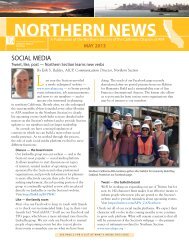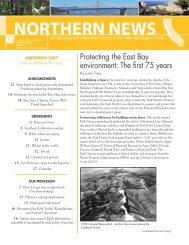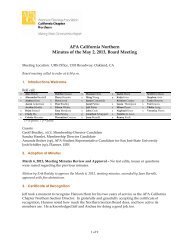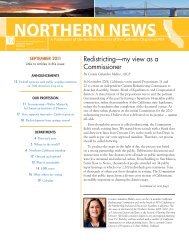Plan-it sustainably - Northern California Section
Plan-it sustainably - Northern California Section
Plan-it sustainably - Northern California Section
You also want an ePaper? Increase the reach of your titles
YUMPU automatically turns print PDFs into web optimized ePapers that Google loves.
What others are saying (continued from previous page)sun and the Earth cancel out — about four times thedistance from the Earth to the moon. They would outf<strong>it</strong> anear-Earth asteroid w<strong>it</strong>h a ‘mass driver,’ a device consistingof electromagnets that would serve both as a rocket to pushthe asteroid to the L1 point and hurl asteroid-derived matter— sun-shielding dust — away from the giant rock. Thelargest near-Earth asteroid, 1036 Ganymede, could maintaina dust cloud large enough to block out 6.58 percent of thesolar radiation that would normally reach Earth, more thanenough to combat any current global warming trends.”—Charles Choi, “Asteroid dust could fight climate changeon Earth,” LiveScience, Sept. 28, 2012.Homes and services before freewayshttp://nyti.ms/RYgAPbMore and more Americans, educated 20-somethings andempty nesters among them, want to live downtown. Plentyof downtowns are coming back; many are thriving. Even so,we remain a nation in thrall to suburbs, highways, cars. Thelarge new Louisville Waterfront Park designed by HargreavesAssociates of San Francisco, built partly under the interstates,has become a recent source of civic pride. Gettingthere requires crossing several busy roadways, and the parkis practically inaccessible w<strong>it</strong>hout a car. But <strong>it</strong>’s popular.Louisville has good bones, good arch<strong>it</strong>ects, and some goodideas. For three decades the c<strong>it</strong>y has wrestled w<strong>it</strong>h the interstateand bridge problem. But removing the highways, ordownscaling them, might turn downtown and <strong>it</strong>s adjacentneighborhoods, including the riverfront, into more attractiveplaces. And where highways have come down in other c<strong>it</strong>ies,property values have gone up. What brings life to a c<strong>it</strong>y areattractions, services, homes, and walkable streets. We seetraffic problems today and ask how to ease them. But <strong>it</strong>’sbetter to start by thinking about what kind of streets andneighborhoods a c<strong>it</strong>y wants, what kind of waterfront <strong>it</strong>should have, and how mass trans<strong>it</strong> could change things.First things first.” —Michael Kimmelman, “Does Louisvilleneed more highways?” The New York Times, Sept. 26, 2012.Bring consumers into the electric<strong>it</strong>ymarketplace http://b<strong>it</strong>.ly/Q9LHlm“Americans shop viciously for bargains, but when <strong>it</strong> comes toelectric<strong>it</strong>y, we simply wr<strong>it</strong>e checks for the bills we receive.A new study from two UC Davis economists suggests that ifwe had the right information, we could become enlightenedshoppers, saving money buying cheap low-pollution hydro orwind power in the middle of the night while turning off theexpensive stuff made w<strong>it</strong>h fossil fuels in the late afternoon.In a study of a few hundred homes in Connecticut, the Davisresearchers found that when they gave consumers HomeArea Network dig<strong>it</strong>al devices w<strong>it</strong>h real-time informationabout electrical prices and electric<strong>it</strong>y use, and then raised theprice of their electric<strong>it</strong>y during hot days, consumers cut backon their usage by 8 to 21 percent. Homes that were onlygiven information on the price of the power, and no informationabout their own usage, only cut back during peak timesby 1 to 7 percent.” —Lisa Margonelli, “Could the Smart Gridfinally do some good for consumers?” in Pacific Standard,Sept. 26, 2012. Download the study: Katrina Jessoe andDavid Rapson, “Knowledge is (less) power: Experimentalevidence from residential energy use,” August 2012, 43 pp.http://b<strong>it</strong>.ly/SZI330The climate on Fox Newshttp://b<strong>it</strong>.ly/Q6RKam“Is the climate changing and are humans responsible? There’svirtually no debate in the scientific world that the answer toboth questions is yes, but public opinion is confused andconflicted. [One] explanation: simple misinformation[including] through mainstream news organizations. TheUnion of Concerned Scientists has just released a studyent<strong>it</strong>led ‘Is News Corp. failing science?’ It looks at climatechange coverage in two influential arms of Rupert Murdoch’smedia empire: the Fox News Channel and the ed<strong>it</strong>orial pageof the Wall Street Journal. ‘Over a recent six-month period,93 percent of Fox News Channel’s representations of climatechange were misleading (37 out of 40 instances),’ the reportstates. ‘Similarly, over the past year, 81 percent of therepresentations of climate science in the WSJ’s opinionsection were misleading (39 out of 48 instances).’ The FoxNews Channel [is the] bigger concern. It’s really troublingwhen there’s no counter-balancing voice presenting actualfacts.” —Tom Jacobs, “Fox News misleads viewers on climatechange,” Pacific Standard, Sept. 25, 2012. Download the studyby Aaron Huertas and Dena Adler, Union of ConcernedScientists, Sept. 2012: http://b<strong>it</strong>.ly/PNHAft n<strong>Northern</strong> News 20 November 2012





![[NAME OF EVENT] EVALUATION FORM](https://img.yumpu.com/32351925/1/190x245/name-of-event-evaluation-form.jpg?quality=85)

